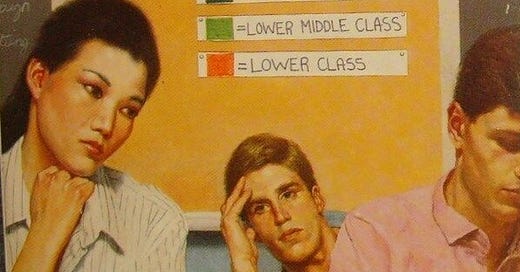By Jim McMurtry, Ph.D. (University of Toronto)
One of my first assignments as a teacher was English 9, and a popular American novel at the time was The War Between the Classes in which the fictional teacher plays a Color Game with his students to deepen their understanding of class struggle. The novel was an eighties riff of the novel and play West Side Story and its truths about the immigrant experience for Puerto Rican immigrants in the late fifties. The former is based on a true story of a teacher who was later sued by the parents of one high school student who claimed her experience as a ‘lower-class’ Color Game participant had got out of hand and traumatized her.”
The fictional principal rigs the game so that poorer, hard-luck students of color are assigned to the upper class and many of the affluent white kids end up in the lowest class. In each color class the female players are of a higher status than the male players. Players must bow and otherwise curry favour with higher-status players.
In addition, “Inferior colors may not speak with or socialize with superior colors. A superior color may address an inferior one, but not vice versa.” A lower colour, such as an “Orange” student, can be fined, harassed, humiliated, and demoted as well as forced to run errands, sit at the back of the class, or go to the end of the cafeteria lineup; and if they object, they get punished further. In contrast, students at the top are never punished, because they are “Blues.”
I played this game with my grade 9 students for years and graded them on their performance. Inevitably a student would break from the herd and come to me with a complaint about the activity, at which point I would immediately stop the game and tell the student that he or she has won, for the academic point, and the moral of the story, is not to conform to societal evil but work against it.
The novel ends with a stereotypically talented Asian student of the highest “Blue” class leading a rebellion, with all the students eventually embracing and left convinced of the iniquity of a caste system. Oddly, if my employer or regulatory body were to find out that I had played the Color Game with my students in recent years, what’s left of my credibility would smash against the shoals of the woke teaching world. I, too, would be accused of traumatizing students.
What made school authorities of another era choose The War Between the Classes as a class novel was not its literary form or effect but its moral: in mixed-race classes it is imperative that students treat each other with equal dignity and not in accordance to their race or social class or any other externality.
The eight Professional Standards for British Columbia teachers are rather mundane, but in 2022 a ninth standard was added:
Educators respect and value the history of First Nations, Inuit and Métis in Canada and the impact of the past on the present and the future. Educators contribute towards truth, reconciliation and healing…[and] integrate First Nations, Inuit and Métis worldviews and perspectives into learning environments.
There is nothing said about directing a critical eye to Indigenous “worldviews and perspectives,” which is relevant to me as I was led out of classroom and career in 2021 for questioning the claim of the Tk̓emlúps te Secwépemc First Nation in Kamloops, British Columbia that Christian teachers murdered 215 students at a long-ago-shuttered Indian Residential School in their community. What is troubling for me about Professional Standard 9 is the special attention given in a multicultural school setting to one group of students distinguished by race alone.
As a teacher under investigation for much of the past four years, generally for not proselytizing for the woke cult in schools, I have been given a handout of these standards on many occasions and can boast of a deep collection. The first eight are not polemical, but the ninth is about one class of citizens, the new Blues. In reality, there are many groups of students across Canada in the K-12 system who are now labelled intersectional or oppressed or placed highly on the Olympic podium of victimhood. The rest are Greens or Oranges.
Did school authorities read The War Between the Classes? I guess not.
(Jim was a former college lecturer as well as principal of Neuchâtel Junior College in Switzerland but mostly a high school teacher in Canada; his father, Roy, was a chief justice and politician who fought for equal rights.)
___
Thanks for reading. For more from this author, read The many faces of conformity
Support Woke Watch Canada by upgrading to a paid membership:
Or, by contributing to our Donor Box:
Woke Watch Canada Essentials:
James Pew contributed a chapter to the best-selling book Grave Error: How The Media Misled us (And the Truth about Residential Schools). You can read about it here - The Rise of Independent Canadian Researchers
A long-form essay by Dr. M - Fulcrum and Pivot: The New Left Remaking of Toronto School Policy
For evidence of the ideological indoctrination in Canadian education, read Yes, schools are indoctrinating kids! And also, Yes, The University is an Indoctrination Camp!





A very informative essay, Jim. Reading about the dysfunctional smorgasbord that characterizes contemporary education makes me thankful I went to high school when reason and logic governed the curriculum. Hard to believe that such inspiring novelists like Hemingway, Steinbeck and Orwell have been usurped by such irrelevant verbiage and no longer stimulate the developing minds of students. As Hemingway once said, "There is no friend as loyal as a book.”
Interesting story about that game and playing it with your students. And wow--that "ninth standard" is crazy, basically a moral browbeating, enfranchised guilt AND all the Hail Mary's that need to be said! Including that meaningless buzz phrase "truth, reconciliation, and healing" too.